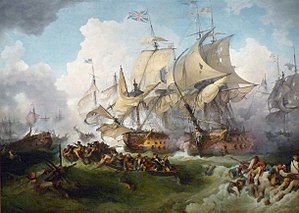Sea battle on the 13th Prairial

Battle of June 1, 1794,
Philippe-Jacques de Loutherbourg, 1795
The two flagships in action.
On the left the Queen Charlotte , on the right the Montagne .
| date | June 1, 1794 |
|---|---|
| place | approx. 400 nautical miles west of Ouessant (English: Ushant) in the Atlantic Ocean |
| output | British tactical victory
French strategic victory |
| Parties to the conflict | |
|---|---|
| Commander | |
| Troop strength | |
| 25 ships of the line | 26 ships of the line |
| losses | |
|
287 dead |
1,500 dead |
First Coalition War (1792–1797)
Verdun - Thionville - Valmy - Lille - Mainz (1792) - Jemappes - Namur - Neerektiven - Mainz (1793) - Famars - Valenciennes (1793) - Arlon (1793) - Hondschoote - Meribel - Avesnes-le-Sec - Pirmasens - Toulon - Fontenay-le-Comte - Cholet - Lucon - Trouillas - Menin - Wattignies - Biesingen - Kaiserslautern (1793) - First Battle of Weissenburg (1793) - Second Battle of Weissenburg (1793) - Boulou - Tourcoing - Tournay - 13th Prairial - Fleurus - Vosges - Aldenhoven - San-Lorenzo de la Muga - Genoa - Hyeres - Handschuhsheim - Mainz (1795) - Loano - Montenotte - Millesimo - Dego - Mondovi - Lodi - Borghetto - Castiglione - Mantua - Siegburg - Altenkirchen - Wetzlar - Kircheib - Kehl - Kalteiche - Malsch - Neresheim - Deining - Amberg - Würzburg - Rovereto - Bassano - Limburg - Biberach I - Emmendingen - Schliengen - Arcole - Fall von Kehl - Rivoli (1797) - St. Vincent - Diersheim - Santa Cruz - Neuwied - Camperduin
The naval battle on the 13th Prairial between the French Revolutionary Fleet and the Royal Navy took place on June 1, 1794. It is also referred to by the British as the " Glorious First of June ". The French called the battle according to the republican calendar , as the battle took place on the 13th day of the month of Prairial (the "meadow month ").
background
Due to the food shortage in France, the French government bought large quantities of grain in the US. The task of the British “ Channel Fleet ” with 26 ships of the line under Admiral Richard Earl Howe was to intercept and destroy the French convoy with over 100 cargo ships coming from Chesapeake Bay ( North America ). The French admiral Villaret de Joyeuse was to receive the convoy west of Ouessant with his fleet of 26 ships of the line and escort it safely to Brest . On board his flagship was also the naval commissioner of the welfare committee , Jeanbon St. André , who was supposed to enforce the priority of food delivery.
prehistory
On May 28, there was a battle between the British ships of the line, HMS Bellerophon (74 cannons), HMS Russell (74), HMS Marlborough (74) and HMS Thunderer (74) and the French triplane Revolutionnaire (114). The French ship was so badly damaged that it was sent to its home port.
On May 29, both fleets faced each other in battle line . Howe ordered the break through the French line. However, only a few of his ships were able to obey the order, since the British were in leeward position . Nevertheless, some French ships of the line were severely damaged and the French broke off the fight. The Indomptable (80) had to be towed to Brest.
On May 30th and 31st, fog prevented the fight from continuing. Villaret lured the British ships after them while the convoy passed unseen the scene of the fighting the previous day. The French were able to replace their losses with escort ships. On the evening of May 31st, the two fleets came into view again, but Howe avoided a night battle.
The battle
On the morning of June 1, the two fleets met again in the battle line on a west course. British ships - this time windward - broke the French line. Both fleets suffered heavy losses in bitter hand-to-hand combat. Villaret managed after several hours of duel between his flagship Montagne and Queen Charlotte , Howes' flagship, to evade the battle. He was able to regroup some of his ships and build a battle line again. However, eight French ships of the line were cut off from the majority and had to delete the flag. The French were later able to recapture one of them. The Vengeur du Peuple was so badly damaged after a four-hour battle with the Brunswick that she finally sank. In the early afternoon Villaret finally broke off the fight and withdrew to Brest. He had to tow some de-masted ships. Eight British ships were badly damaged, of which the Marlborough and the Defense were dismasted, which is why Howe refrained from pursuing the French. It took him several days to secure the captured ships.
On board the Tremendous , Mrs. Daniel Mackenzie gave birth to a boy, Daniel Tremendous Mackenzie, who was later awarded the Naval General Service Medal, in recognition of his presence during the battle (classified as "Baby").
Conclusion
With six ships of the line captured, Howe could claim tactical victory in battle; strategically, the French were able to achieve their goal of getting the grain transport through the blockade.
In the course of the battle it became clear that the fleet of revolutionary France, weakened by the purges in the officer corps and the disloyal attitude of the remaining mostly noble officers towards the new government, was inferior to the British fleet tactically and in terms of training.
Graphics
literature
- Helmut Pemsel : World history of seafaring. Volume 6: Command of the Sea. Part 2: Maritime Wars and Maritime Politics from 1650 to 1914. Koehler, Hamburg 2005, ISBN 3-7822-0838-2 .


